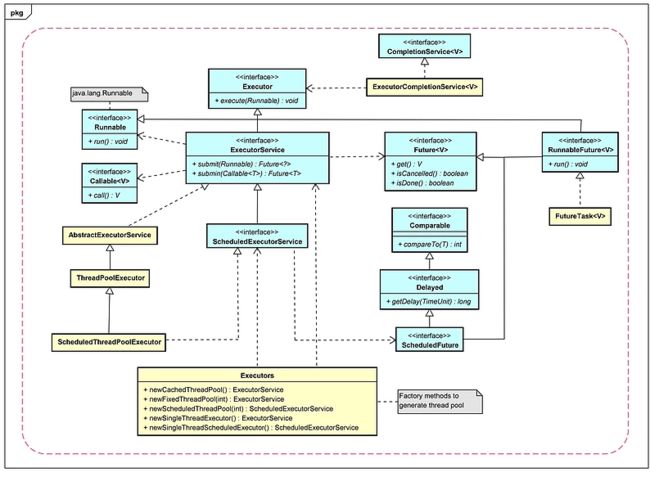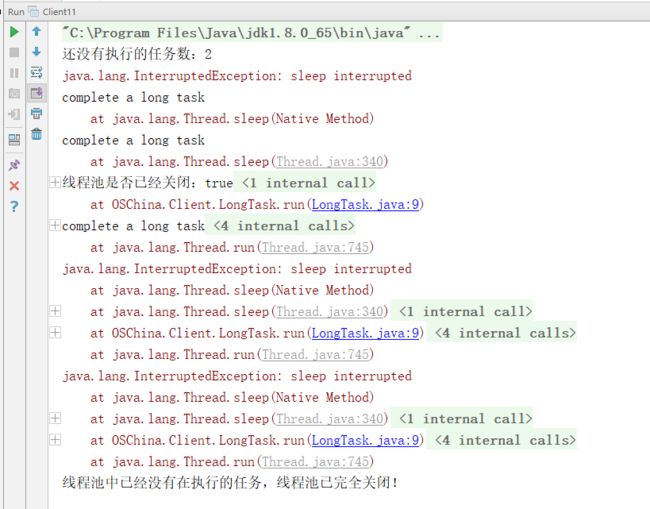引言
Executor框架是指JDK 1.5中引入的一系列并发库中与Executor相关的功能类,包括Executor、Executors、ExecutorService、Future、Callable等。
一、为什么要引入Executor框架?
1、如果使用new Thread(...).start()的方法处理多线程,有如下缺点:
① 开销大。对于JVM来说,每次新建线程和销毁线程都会有很大的开销。
② 线程缺乏管理。没有一个池来限制线程的数量,如果并发量很高,会创建很多线程,而且线程之间可能会有相互竞争,这将会过多占用系统资源,增加系统资源的消耗量。而且线程数量超过系统负荷,容易导致系统不稳定。
2、使用线程池的方法,有如下优点:
① 线程复用。通过复用创建了的线程,减少了线程的创建、消亡的开销。
② 有效控制并发线程数。
③ 提供了更简单灵活的线程管理。可以提供定时执行、单线程、可变线程数等多种使用功能。
二、Executor框架的UML图
三、下面开始分析一下Executor框架中几个比较重要的接口和类。
1、Callable
Callable位于java.util.concurrent包下,它是一个接口,只声明了一个call()方法。
Callable接口类似于Runnable,两者都是为了可能在线程中执行的类而设计的。和Runnable接口中的run()方法类似,Callable 提供的call()方法作为线程的执行体。但是call()比run()方法更强大,体现在
① call方法有返回值。
② call方法可以声明抛出异常。
2、Future
Future 接口位于java.util.concurrent包下,是Java 1.5中引入的接口。
Future主要用来对具体的Runnable或Callable任务的执行结果进行取消、查询是否完成、获取结果。必要时可以通过get()方法获取执行结果,get()方法会阻塞知道任务返回结果。
当你提交一个Callable对象给线程池时,将得到一个Future对象,并且它和你传入的Callable示例有相同泛型。
Future 接口中的5个方法:
public interface Future {
//用来取消任务
//参数mayInterruptIfRunning表示是否允许取消正在执行却没有执行完毕的任务。
boolean cancel(boolean mayInterruptIfRunning);
//表示任务是否被取消成功
boolean isCancelled();
//表示任务是否已经完成
boolean isDone();
//用来获取执行结果,这个方法会产生阻塞,会一直等到任务执行完毕才返回;
V get()
//用来获取执行结果,如果在指定时间内,还没获取到结果,会抛出TimeoutException异常。
V get(long timeout, TimeUnit unit)
} Future提供了三种功能:
① 判断任务是否完成
② 能够中断任务
③ 能够获取任务执行结果
3、Executor
Executor是一个接口,它将任务的提交与任务的执行分离开来,定义了一个接收Runnable对象的方法executor。Executor是Executor框架中最基础的一个接口,类似于集合中的Collection接口。
4、ExecutorService
ExecutorService继承了Executor,是一个比Executor使用更广泛的子类接口。定义了终止任务、提交任务、跟踪任务返回结果等方法。
一个ExecutorService是可以关闭的,关闭之后它将不能再接收任何任务,对于不在使用的ExecutorService,应该将其关闭以释放资源。
ExecutorService方法介绍:
package java.util.concurrent;
import java.util.List;
import java.util.Collection;
public interface ExecutorService extends Executor {
/**
* 平滑地关闭线程池,已经提交到线程池中的任务会继续执行完。
*/
void shutdown();
/**
* 立即关闭线程池,返回还没有开始执行的任务列表。
* 会尝试中断正在执行的任务(每个线程调用 interruput方法),但这个行为不一定会成功。
*/
List shutdownNow();
/**
* 判断线程池是否已经关闭
*/
boolean isShutdown();
/**
* 判断线程池的任务是否已经执行完毕。
* 注意此方法调用之前需要先调用shutdown()方法或者shutdownNow()方法,否则总是会返回false
*/
boolean isTerminated();
/**
* 判断线程池的任务是否都执行完。
* 如果没有任务没有执行完毕则阻塞,直至任务完成或者达到了指定的timeout时间就会返回
*/
boolean awaitTermination(long timeout, TimeUnit unit)
throws InterruptedException;
/**
* 提交带有一个返回值的任务到线程池中去执行(回调),返回的 Future 表示任务的待定结果。
* 当任务成功完成后,通过 Future 实例的 get() 方法可以获取该任务的结果。
* Future 的 get() 方法是会阻塞的。
*/
Future submit(Callable task);
/**
*提交一个Runnable的任务,当任务完成后,可以通过Future.get()获取的是提交时传递的参数T result
*
*/
Future submit(Runnable task, T result);
/**
* 提交一个Runnable的人无语,它的Future.get()得不到任何内容,它返回值总是Null。
* 为什么有这个方法?为什么不直接设计成void submit(Runnable task)这种方式?
* 这是因为Future除了get这种获取任务信息外,还可以控制任务,
具体体现在 Future的这个方法上:boolean cancel(boolean mayInterruptIfRunning)
这个方法能够去取消提交的Rannable任务。
*/
Future submit(Runnable task);
/**
* 执行一组给定的Callable任务,返回对应的Future列表。列表中每一个Future都将持有该任务的结果和状态。
* 当所有任务执行完毕后,方法返回,此时并且每一个Future的isDone()方法都是true。
* 完成的任务可能是正常结束,也可以是异常结束
* 如果当任务执行过程中,tasks集合被修改了,那么方法的返回结果将是不确定的,
即不能确定执行的是修改前的任务,还是修改后的任务
*/
List> invokeAll(Collection> tasks)
throws InterruptedException;
/**
* 执行一组给定的Callable任务,返回对应的Future列表。列表中每一个Future都将持有该任务的结果和状态。
* 当所有任务执行完毕后或者超时后,方法将返回,此时并且每一个Future的isDone()方法都是true。
* 一旦方法返回,未执行完成的任务被取消,而完成的任务可能正常结束或者异常结束,
* 完成的任务可以是正常结束,也可以是异常结束
* 如果当任务执行过程中,tasks集合被修改了,那么方法的返回结果将是不确定的
*/
List> invokeAll(Collection> tasks,
long timeout, TimeUnit unit)
throws InterruptedException;
/**
* 执行一组给定的Callable任务,当成功执行完(没抛异常)一个任务后此方法便返回,返回的是该任务的结果
* 一旦此正常返回或者异常结束,未执行的任务都会被取消。
* 如果当任务执行过程中,tasks集合被修改了,那么方法的返回结果将是不确定的
*/
T invokeAny(Collection> tasks)
throws InterruptedException, ExecutionException;
/**
* 执行一组给定的Callable任务,当在timeout(超时)之前成功执行完(没抛异常)一个任务后此方法便返回,返回的是该任务的结果
* 一旦此正常返回或者异常结束,未执行的任务都会被取消。
* 如果当任务执行过程中,tasks集合被修改了,那么方法的返回结果将是不确定的
*/
T invokeAny(Collection> tasks,
long timeout, TimeUnit unit)
throws InterruptedException, ExecutionException, TimeoutException;
} shutdown() 和 shutdownNow() 是用来关闭连接池的两个方法,而且这两个方法都是在当前线程立即返回,不会阻塞至线程池中的方法执行结束。调用这两个方法之后,连接池将不能再接受任务。
下面给写几个示例来加深ExecutorService的方法的理解。
先写两个任务类:ShortTask和LongTask,这两个类都继承了Runnable接口,ShortTask的run()方法执行很快,LongTask的run()方法执行时间为10s。
public class LongTask implements Runnable {
@Override
public void run() {
try {
TimeUnit.SECONDS.sleep(10L);
} catch (InterruptedException e) {
e.printStackTrace();
}
System.out.println("complete a long task");
}
}public class ShortTask implements Runnable {
@Override
public void run() {
System.out.println("complete a short task...");
}
}测试shutdown()方法
package OSChina.Client;
import java.text.SimpleDateFormat;
import java.util.Date;
import java.util.concurrent.*;
public class Client10 {
public static void main(String[] args) {
ExecutorService threadpool = Executors.newFixedThreadPool(4);
threadpool.submit(new ShortTask());
threadpool.submit(new ShortTask());
threadpool.submit(new LongTask());
threadpool.submit(new ShortTask());
threadpool.shutdown();
boolean isShutdown = threadpool.isShutdown();
System.out.println("线程池是否已经关闭:" + isShutdown);
final SimpleDateFormat sdf = new SimpleDateFormat("HH:mm:ss");
try {
while (!threadpool.awaitTermination(1L, TimeUnit.SECONDS)){
System.out.println("线程池中还有任务在执行,当前时间:" + sdf.format(new Date()));
}
System.out.println("线程池中已经没有在执行的任务,线程池已完全关闭!");
} catch (InterruptedException e) {
e.printStackTrace();
}
}
}
测试shutdownNow()方法
package OSChina.Client;
import java.text.SimpleDateFormat;
import java.util.Date;
import java.util.List;
import java.util.concurrent.ExecutorService;
import java.util.concurrent.Executors;
import java.util.concurrent.TimeUnit;
public class Client11 {
public static void main(String[] args) {
ExecutorService threadpool = Executors.newFixedThreadPool(3);
//将5个任务提交到有3个线程的线程池
threadpool.submit(new LongTask());
threadpool.submit(new LongTask());
threadpool.submit(new LongTask());
threadpool.submit(new LongTask());
threadpool.submit(new LongTask());
try {
TimeUnit.SECONDS.sleep(1L);
//关闭线程池
List waiteRunnables = threadpool.shutdownNow();
System.out.println("还没有执行的任务数:" + waiteRunnables.size());
boolean isShutdown = threadpool.isShutdown();
System.out.println("线程池是否已经关闭:" + isShutdown);
final SimpleDateFormat sdf = new SimpleDateFormat("HH:mm:ss");
while (!threadpool.awaitTermination(1L, TimeUnit.SECONDS)) {
System.out.println("线程池中还有任务在执行,当前时间:" + sdf.format(new Date()));
}
System.out.println("线程池中已经没有在执行的任务,线程池已完全关闭!");
} catch (InterruptedException e) {
e.printStackTrace();
}
}
}
当调用shutdownNow()后,三个执行的任务都被interrupt了。而且awaitTermination(1L, TimeUnit.SECONDS)返回的都是true。
测试submit(Callable
package OSChina.Client;
import java.util.concurrent.Callable;
import java.util.concurrent.TimeUnit;
public class CallableTask implements Callable{
@Override
public Object call() throws Exception {
TimeUnit.SECONDS.sleep(5L);
return "success";
}
}
package OSChina.Client;
import java.text.SimpleDateFormat;
import java.util.Date;
import java.util.concurrent.ExecutionException;
import java.util.concurrent.ExecutorService;
import java.util.concurrent.Executors;
import java.util.concurrent.Future;
public class Client12 {
public static void main(String[] args) {
ExecutorService threadpool = null;
threadpool = Executors.newFixedThreadPool(3);
final SimpleDateFormat sdf = new SimpleDateFormat("HH:mm:ss");
System.out.println("提交一个callable任务到线程池,现在时间是:" + sdf.format(new Date()));
Future future = threadpool.submit(new CallableTask());
try {
System.out.println("获取callable任务的结果:" + future.get() + ",现在时间是:" + sdf.format(new Date()));
} catch (InterruptedException e) {
e.printStackTrace();
} catch (ExecutionException e) {
e.printStackTrace();
} finally {
if(threadpool!=null){
threadpool.shutdown();
}
}
}
}
素小暖讲Java@目录



